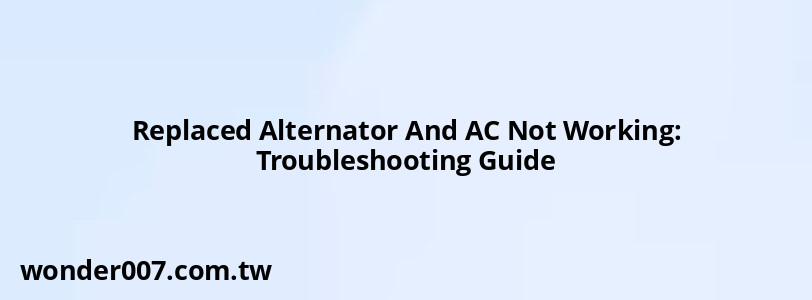Replaced Alternator And AC Not Working: Troubleshooting Guide
213
0

Replacing an alternator and finding that the AC is not working can be frustrating. This issue often arises from electrical or mechanical problems related to the alternator replacement. Below, we’ll explore common causes and solutions.
Replaced Alternator And AC Not Working
Common Causes of AC Failure After Alternator Replacement
- Electrical Connections: Loose or disconnected wiring during alternator replacement can disrupt the AC system.
- Blown Fuse: A power surge during alternator installation may blow a fuse connected to the AC system.
- Faulty Alternator: A defective or incompatible alternator may not supply sufficient power to the AC compressor.
- Damaged Belt: If the serpentine belt was not properly reinstalled, it could affect both the alternator and AC compressor.
- AC Compressor Issues: The compressor may have coincidentally failed or been damaged during repairs.
How to Diagnose the Problem
- Inspect Wiring: Check all electrical connections near the alternator and AC system for loose or damaged wires.
- Test Fuses: Use a multimeter to test fuses related to the AC system and replace any that are blown.
- Check Alternator Output: Use a voltmeter to ensure the alternator is providing adequate voltage (usually 13.5–14.5 volts).
- Examine Belts: Inspect the serpentine belt for proper tension and alignment.
- Run an AC System Test: Turn on the AC and listen for unusual noises or check if the compressor engages.
Steps to Fix the Issue
- Reconnect Wires: Secure any loose connections and repair damaged wires.
- Replace Blown Fuses: Install new fuses with the correct amperage rating for your vehicle.
- Verify Alternator Compatibility: Ensure that the replacement alternator matches your vehicle’s specifications.
- Adjust or Replace Belt: Tighten or replace the serpentine belt if necessary.
- Service the AC System: If none of the above resolves the issue, consult a professional mechanic to inspect and repair the AC compressor.
Preventive Tips for Avoiding Issues
- Double-check Connections: Ensure all wires are securely connected during alternator installation.
- Use Quality Parts: Always use OEM (Original Equipment Manufacturer) parts for compatibility and reliability.
- Follow Installation Guidelines: Adhere to manufacturer-recommended procedures when replacing components.
FAQs About Replaced Alternator And AC Not Working
- Why does my AC stop working after replacing the alternator?
This could be due to loose wiring, a blown fuse, or an incompatible alternator affecting power delivery. - How do I know if my alternator is faulty?
Check its voltage output with a multimeter. A healthy alternator typically outputs 13.5–14.5 volts. - Can a bad serpentine belt cause AC issues?
Yes, a misaligned or damaged belt can prevent proper operation of both the alternator and AC compressor.
---
Related Posts
-
2002 Chevy Trailblazer Power Steering Pump Guide
29-01-2025 • 123 views -
2001 Pontiac Sunfire Radio Wiring Harness: Installation Guide
27-01-2025 • 99 views -
Ford Explorer: Troubleshooting Cold Air from the Heater
26-01-2025 • 132 views -
2007 Honda Accord Timing Belt Replacement Guide
28-01-2025 • 150 views -
Chevy Silverado: Troubleshooting No Power Issues
29-01-2025 • 226 views
Latest Posts
-
2015 Chevy Traverse AC Recharge Port Location
01-02-2025 • 409 views -
Are O2 Sensors Covered Under Warranty
01-02-2025 • 376 views -
Rear Brake Caliper Piston Won't Compress
01-02-2025 • 356 views -
Power Steering Fluid Leak On Passenger Side
01-02-2025 • 457 views -
How To Turn Off Paddle Shifters Mercedes
01-02-2025 • 377 views
Popular Posts
-
EPC Light: Understanding Causes and Solutions
26-01-2025 • 1053 views -
EPC Warning Light: What It Means for Your Vehicle
27-01-2025 • 630 views -
Hino Warning Lights: Understanding Dashboard Alerts
26-01-2025 • 765 views -
V12 Engine Costs: What You Need to Know
26-01-2025 • 679 views -
Power Steering and ABS Light On: Causes and Solutions
27-01-2025 • 643 views
